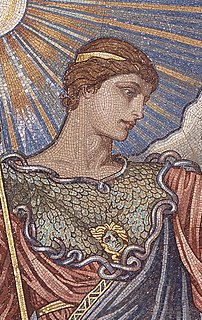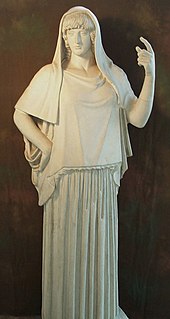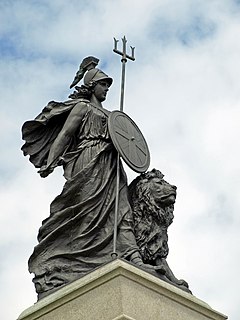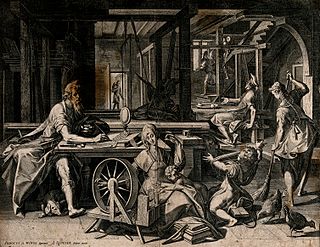Related Research Articles

Boudica or Boudicca, also known as Boadicea or Boudicea, and in Welsh as Buddug, was a queen of the British Celtic Iceni tribe who led an uprising against the occupying forces of the Roman Empire in AD 60 or 61. She died shortly after its failure and was said to have poisoned herself. She is considered a British folk hero.

Minerva is the Roman goddess of wisdom and strategic warfare and the sponsor of arts, trade, and strategy. From the second century BC onward, the Romans equated her with the Greek goddess Athena, though the Romans did not stress her relation to battle and warfare as the Greeks did.

Roman Polański is a Polish-French film director, producer, writer, and actor.

The Roman Empire was the post-Republican period of ancient Rome. As a polity it included large territorial holdings around the Mediterranean Sea in Europe, North Africa and West Asia ruled by emperors. From the accession of Caesar Augustus to the military anarchy of the third century, it was a principate with Italy as metropole of the provinces and its city of Rome as sole capital. Although fragmented briefly during the military crisis, the empire was forcibly reassembled, then ruled by multiple emperors who shared rule over the Western Roman Empire and over the Eastern Roman Empire. Rome remained the nominal capital of both parts until 476 AD, when it sent the imperial insignia to Constantinople following the capture of Ravenna by the barbarians of Odoacer and the subsequent deposition of Romulus Augustus. The fall of the Western Roman Empire to Germanic kings, along with the hellenization of the Eastern Roman Empire into the Byzantine Empire, conventionally marks the end of Ancient Rome and the beginning of the Middle Ages.

In Ancient Greek religion, Hestia is the virgin goddess of the hearth, the right ordering of domesticity, the family, the home, and the state. In Greek mythology, she is the daughter and firstborn child of Kronos and Rhea.

Venus is a Roman goddess, whose functions encompassed love, beauty, desire, sex, fertility, prosperity and victory. In Roman mythology, she was the ancestor of the Roman people through her son, Aeneas, who survived the fall of Troy and fled to Italy. Julius Caesar claimed her as his ancestor. Venus was central to many religious festivals, and was revered in Roman religion under numerous cult titles.

Isis was a major goddess in ancient Egyptian religion whose worship spread throughout the Greco-Roman world. Isis was first mentioned in the Old Kingdom as one of the main characters of the Osiris myth, in which she resurrects her slain husband, the divine king Osiris, and produces and protects his heir, Horus. She was believed to help the dead enter the afterlife as she had helped Osiris, and she was considered the divine mother of the pharaoh, who was likened to Horus. Her maternal aid was invoked in healing spells to benefit ordinary people. Originally, she played a limited role in royal rituals and temple rites, although she was more prominent in funerary practices and magical texts. She was usually portrayed in art as a human woman wearing a throne-like hieroglyph on her head. During the New Kingdom, as she took on traits that originally belonged to Hathor, the preeminent goddess of earlier times, Isis was portrayed wearing Hathor's headdress: a sun disk between the horns of a cow.

In Roman mythology, Romulus and Remus are twin brothers, whose story tells the events that led to the founding of the city of Rome and the Roman Kingdom by Romulus. The killing of Remus by his brother, and other tales from their story, have inspired artists throughout the ages. Since ancient times, the image of the twins being suckled by a she-wolf has been a symbol of the city of Rome and the Roman people. Although the tale takes place before the founding of Rome around 750 BC, the earliest known written account of the myth is from the late 3rd century BC. Possible historical basis for the story, as well as whether the twins' myth was an original part of Roman myth or a later development, is a subject of ongoing debate.

Cleopatra VII Philopator was the last active ruler of the Ptolemaic Kingdom of Egypt, nominally survived as pharaoh by her son Caesarion. As a member of the Ptolemaic dynasty, she was a descendant of its founder Ptolemy I Soter, a Macedonian Greek general and companion of Alexander the Great. After the death of Cleopatra, Egypt became a province of the Roman Empire, marking the end of the Hellenistic period that had lasted since the reign of Alexander. Her native language was Koine Greek, and she was the first Ptolemaic ruler to learn the Egyptian language.

Antony and Cleopatra is a tragedy by William Shakespeare. The play was first performed, by the King's Men, at either the Blackfriars Theatre or the Globe Theatre in around 1607; its first appearance in print was in the Folio of 1623.

Mary was a first-century BC Galilean Jewish woman of Nazareth, and the mother of Jesus, according to the New Testament and the Quran.

In ancient Roman religion, Ceres was a goddess of agriculture, grain crops, fertility and motherly relationships. She was originally the central deity in Rome's so-called plebeian or Aventine Triad, then was paired with her daughter Proserpina in what Romans described as "the Greek rites of Ceres". Her seven-day April festival of Cerealia included the popular Ludi Ceriales. She was also honoured in the May lustratio of the fields at the Ambarvalia festival, at harvest-time, and during Roman marriages and funeral rites.

Britannia has been used in several different senses, but is best known as a national personification of the United Kingdom. The name is a Latinisation of the native Brittonic word for the island, Pretanī, which also produced the Greek form Prettanike or Brettaniai, which originally, in the fourth to the first centuries BC, designated a collection of islands with individual names, including Albion or Britain. In Modern Welsh the name remains Prydain. By the 1st century BC, Britannia came to be used for Great Britain specifically. After the Roman conquest in 43 AD, Britannia meant Roman Britain, a province covering the island south of Caledonia. When Roman Britain was divided into four provinces in 197 AD, two were called Britannia Superior and Britannia Inferior. Britannia is the name given to the female personification of the island, and it is a term still used to refer to the whole island.

The Whore of Babylon or Babylon the Great is a symbolic female figure and also place of evil mentioned in the Book of Revelation in the Bible. Her full title is stated in Revelation 17 as Mystery, Babylon the Great, the Mother of Prostitutes and Abominations of the Earth.

Victoria, in ancient Roman religion, was the personified goddess of victory. She is the Roman equivalent of the Greek goddess Nike, and was associated with Bellona. She was adapted from the Sabine agricultural goddess Vacuna and had a temple on the Palatine Hill. The goddess Vica Pota was also sometimes identified with Victoria. Victoria is often described as a daughter of Pallas and Styx, and as a sister of Zelus, Kratos, and Bia.

Mary Teresa Bojaxhiu, commonly known as Mother Teresa and honoured in the Catholic Church as Saint Teresa of Calcutta, was an Albanian-Indian Roman Catholic nun and missionary. She was born in Skopje, then part of the Kosovo Vilayet of the Ottoman Empire. After living in Skopje for eighteen years, she moved to Ireland and then to India, where she lived for most of her life.

Priscilla and Aquila were a first century Christian missionary married couple described in the New Testament. Despite prevailing modern Christian views that women did not teach men in the church in early Christianity, it is clear that Priscilla, along with Aquila, taught Apollos, an early Christian preacher who is likely to have been an apostle at the time he was taught Aquila is traditionally listed among the Seventy Disciples. They lived, worked, and traveled with the Apostle Paul, who described them as his "fellow workers in Christ Jesus".

Ruth Roman was an American actress of film, stage, and television.

Onika Tanya Maraj-Petty, known professionally as Nicki Minaj, is an American rapper, singer, and songwriter. Born in Saint James, Port of Spain, and raised in Queens, New York City, she gained public recognition after releasing the mixtapes Playtime Is Over (2007), Sucka Free (2008), and Beam Me Up Scotty (2009).

Birds of Prey , also known as Harley Quinn: Birds of Prey or simply Birds of Prey, is a 2020 American superhero film based on the DC Comics team Birds of Prey. It is the eighth film in the DC Extended Universe and a follow-up to Suicide Squad (2016). It was directed by Cathy Yan and written by Christina Hodson, and it stars Margot Robbie, Mary Elizabeth Winstead, Jurnee Smollett-Bell, Rosie Perez, Chris Messina, Ella Jay Basco, Ali Wong, and Ewan McGregor. The film follows Harley Quinn as she joins forces with Helena Bertinelli, Dinah Lance, and Renee Montoya to save Cassandra Cain from Gotham City crime lord Black Mask.
References
- ↑ Smith, William (1870). Dictionary of Greek and Roman biography and mythology. 1. Boston, Little. p. 535.
| This ancient Roman biographical article is a stub. You can help Wikipedia by expanding it. |